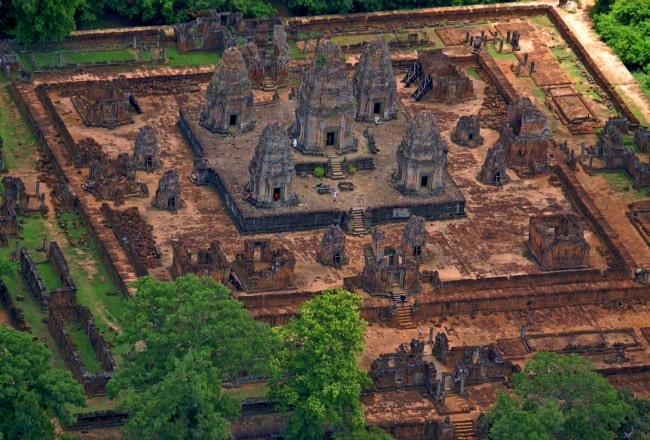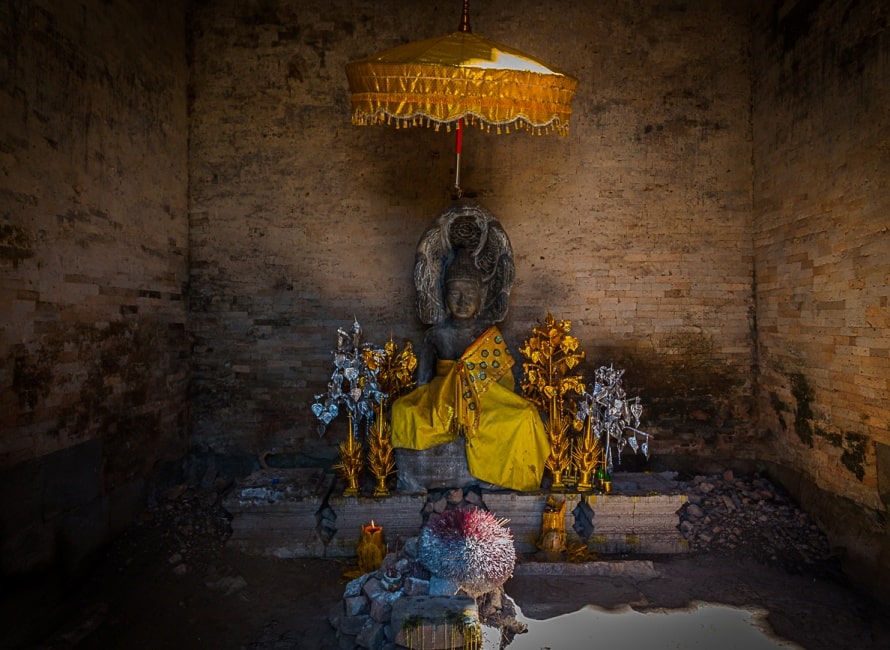There are five towers which sit on top of a three-tiered pyramid. There are three enclosures which surround the temple. The five towers represent the mythical home of the Hindu gods, Mount Meru.
In the middle of each of the four sides there is a landing platform for boats. On each corner, there is a two-metre tall elephant standing guard.

Mountain temple dedicated to Shiva
An inscribed stele found at the site states that the sacred linga Sri Rajendreshvara was consecrated in the year 952 and was placed in the central sanctuary. The outer four surrounding sanctuaries were dedicated to Shiva, Parvati (the wife of Shiva), and the Hindu Gods Vishnu and Brahma.
Like the earlier Phnom Bakheng, the temple was built to represent Mount Meru. The five towers on the square platform symbolize the five peaks of the mythological mountain. The East Mebon however does not have the tiers of the pyramid shaped Phnom Bakheng.
Temple Foundation
The foundation of the East Mebon measures 126 m by 120 m, it has a boat-landing platform on each side. As in the case of other temples constructed in the tenth century, the entrances were covered by wooden roofs. Only the laterite walls and sandstone window frames and columns still remain. The entrances are guarded by two seated lion statues.

Outer enclosure
The outer enclosure wall on the first level measures 108 m by 104 m, it is built of laterite. There are many holes on it, as the top of the wall originally had sandstone sculptures in the forms of candles. Some of them are still in situ. The spouts of the drainage are designed as lion heads. There are long rectangular shrines for pilgrims on this first level surrounding the higher platform.
They are sometimes called galleries, though they are only predecessors of those continuous roofed aisles called galleries at later temples. As with most Angkor temples, the east side is slightly wider than the west side, indicating that the temple is oriented to the east.

Inner enclosure
The inner enclosure that is about 75 meters wide contains the second platform, that also has a guarding elephant on each of its corners.
Inside the inner (first) enclosure are five so-called library buildings at the corners (two in the southeast). There are eight more smaller brick towers surrounding the uppermost platform, in pairs at the cardinal points. They symbolize the eight Hindu guardians of the world's eight cardinal directions.
Furthermore, they enshrined eight Lingams, symbolizing the eight aspects of Shiva, called "Murtis": heavenly bodies Sun and Moon; elements earth, water, wind, fire and ether, last not least the transindividual eternal soul, Atman. The fire shrine, without roof now, is also attributed to Agni, the fire god.

The Second Level
The basis of the second level measures 65 m by 62 m. Most striking features are eight monolithic elephant statues in the corners of two levels. The most complete ones are in the south-west and north-west, the most photogenic in the south-east, the most freestanding in the north-east.
The 2 m high elephants are majestically positioned outside the second enclosure in particular, on an intermediate tier.
Some of the libraries and gateways on this second level bear well-preserved sandstone lintels with exquisite carvings. The most remarkable stone carving is at the east side of the west gate (facing the central platform).
It depicts the lion-man Narasingha (Narasimha) clawing the demon Hiranyakashipu. Narasingha is one of the ten principal Avatars of Vishnu, this means, the lion-man is an embodiment of the god. Vishnu had to transform himself into a man with a lion head, because the mighty demon threatening the world was otherwise invincible, neither man nor animal could kill him.

The Third Level
On the third level there is a large sanctuary (tower) surrounded by four smaller towers at each corner. Here you can see carvings and inscriptions showing Shiva, Indra, and other figures from Hindu mythology. All of the five towers have a door pointing to the east, with fake doors on the other three directions.
The central sanctuary
The central tower was dedicated to Shiva, it sheltered the main Lingam. The northeastern tower was dedicated to Vishnu. The southeastern tower was dedicated to Brahma, completing the Hindu trinity. The northwestern tower was dedicated to King Rajendravarman’s mother, the southwestern one to his father.
According to the foundation inscription, the latter two Prasats sheltered sculptures of Shiva’s consort Uma and of Shiva himself respectively, "in the likeness of the mother and the father" of Rajendravarman II. Each of the five towers originally also had Linga sculptures on Yoni pedestals.
As already mentioned, eight more Lingams were placed inside those eight small towers of the surrounding courtyard. The Lingam in the main sanctuary was called Rajendreshwara, "Rajendra, Lord of the World", indicating that the East Mebon served as Rajendravarman's state temple. It connected worshipping Lord Shiva, as mighty protector of the king, with venerating the royal ancestors.

The holes in the brickwork originally carried stucco dressing the towers. Most lintels remaining in situ are of high-quality craftsmanship. On the central tower, to the east, there is the common subject of Indra on his three-headed elephant, with flights of figures on a tendril disgorged by a Makara crocodile.
A narrow frieze of hermit figures in meditation is above the main panel. To the west there is Skanda, the god of war, on his peacock, with a line of figures holding lotus flowers. Because of the western direction this depiction the god is sometimes identified as Varuna, on a bird instead of his usual mount, the Makara crocodile.
To the south is Shiva on his sacred bull Nandi (or Yama on a bullock). On the south lintel of the south-east tower there is another lintel with Shiva on Nandi. At the north side of the same Prasat, which was dedicated to Brahma, is a monster head devouring an elephant.
The east side of the north-west tower depicts Ganesha curiously riding his own trunk, thereby transformed into a mount. The south lintel of the same Prasat has another strange motif, a figure dancing on a lion.
At the north-east corner building there is a lintel depicting Lakshmi flanked by two elephants with raised trunks sprinkling water on her, a common Hindu and Buddhist motif called "Gajalakshmi", meaning "Elephant-Lakshmi".
The south-east tower has a Garuda on its east side. The lintel of the south-west tower depicts Indra on Airavata, a common subject. A lovely swirling garland surrounds small figures. The rectangular library buildings in the south-west are decorated with motifs of the nine planets or the seven ascetics.
The uppermost platform is 3 m higher and measures 30 m by 30 m. Five brick towers are arranged in quincunx order. The central tower, in particular, has excellent lintel carvings.






 25/12/2025
25/12/2025





































Jolie LIEMMy name is Jolie, I am a Vietnamese girl growing up in the countryside of Hai Duong, northern Vietnam. Since a little girl, I was always dreaming of exploring the far-away lands, the unseen beauty spots of the world. My dream has been growing bigger and bigger day after day, and I do not miss a chance to make it real. After graduating from the univesity of language in Hanoi, I started the exploration with a travel agency and learning more about travel, especially responsible travel. I love experiencing the different cultures of the different lands and sharing my dream with the whole world. Hope that you love it too!